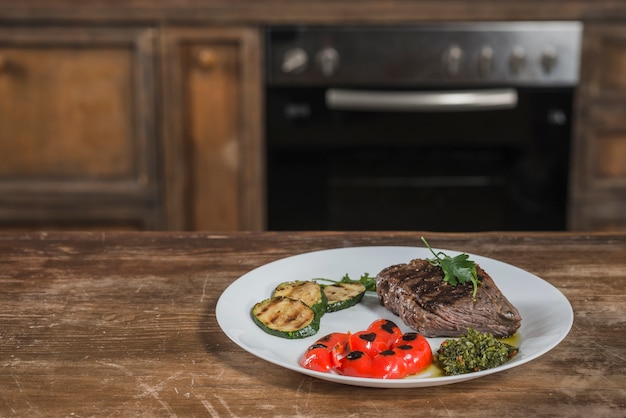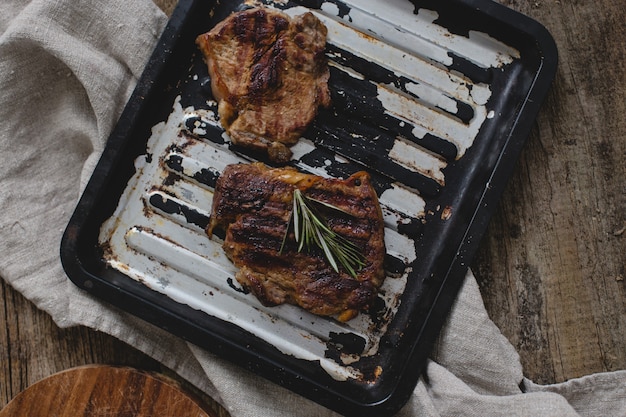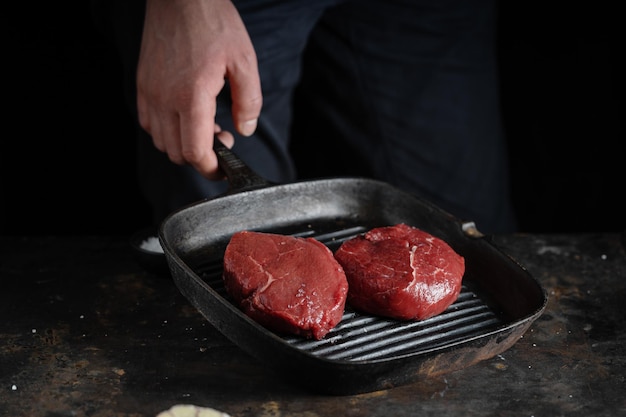Let's talk about steak, shall we? Now, I'm no fancy chef, just a bloke who loves a good, juicy steak. And there's nothing quite like a perfectly cooked t-bone, is there? That satisfying sizzle, the tender meat, the delicious juices - it's a real treat. But let's be honest, sometimes nailing that perfect steak can feel like a bit of a gamble. One minute you're biting into a juicy masterpiece, the next you're wrestling with a dry, chewy nightmare. So, after years of experimenting and a fair few steak-related disasters, I've finally cracked the code for an oven-baked t-bone that's consistently delicious.
This guide isn't just about the cooking process, though. It's about understanding the whole shebang, from picking the perfect steak to serving it up with a side dish that'll make your taste buds sing.
(Part 1) Choosing Your Weapon: The Steak

choosing the right cut: T-Bone Triumph
First things first, let's talk about the steak itself. I'm a big fan of t-bones – that beautiful bone dividing the tenderloin and strip steak just screams "quality" to me. It's like a culinary badge of honor. But, the key to a good t-bone is getting the right cut. Look for a steak that's at least 1.5 inches thick, with good marbling throughout. Marbling, that's the fat streaks throughout the meat, adds flavour and keeps the steak moist. It's like the secret ingredient of a good steak, you see. It's that fat that renders during cooking and gives you those delicious, juicy flavours.
The Meat: Dry-Aged or Not? A Matter of Taste
Now, you'll come across dry-aged steaks, and they're definitely worth trying if you're feeling adventurous and have the budget for it. The aging process concentrates the flavour and tenderizes the meat, giving it a more intense, savory character. But, it can be a bit pricey. If you're on a budget, don't worry, regular cuts can be just as delicious.
Don't be afraid to ask your butcher for advice! They're pros and can help you find the perfect cut for your needs and budget. They'll be able to tell you about the different cuts, their flavour profiles, and how best to cook them.
(Part 2) Preparing the Battleground: Your Oven

The Oven: Your Secret Weapon to a Perfect Steak
Right, now onto the oven. The secret to a perfect oven-baked steak is all about heat. You want a high heat, around 450°F (230°C), to get a lovely sear on the outside and keep the inside juicy. Think of it like a controlled inferno, just the right amount of heat to coax out the best flavors in your steak.
Before you chuck the steak in, make sure your oven is preheated. Preheat the oven for at least 30 minutes, this'll make sure your steak cooks evenly and prevents the temperature from dropping when you open the oven. You don't want to shock your steak with a cold oven, now do you? That's a recipe for disaster!
Setting the Stage: Getting Your Steak Ready
Okay, now the steak itself. Pat it dry with paper towels. It's all about getting that lovely sear, and moisture can prevent it. It's like giving your steak a little spa treatment before it enters the heat. Now, this is where things get interesting. You can season it with just salt and pepper, or get a bit fancier with herbs and spices.
Personally, I love a simple salt and pepper rub. It lets the natural flavour of the meat shine through. It's like letting the steak be the star of the show, you see. You can also add some garlic powder and onion powder, for an extra punch of flavour. But remember, a little goes a long way! It's all about enhancing the natural flavor, not drowning it out.
Now, don't be afraid to let the steak sit at room temperature for 30 minutes before you cook it. This will help it cook more evenly. It's like giving your steak a chance to relax before it goes on stage.
(Part 3) The Great Cook-Off: Searing and Baking

Searing the Steak: The First Battle
Alright, the big moment has arrived. Grab a cast-iron skillet or a heavy-bottomed pan. Heat it up on the stovetop over high heat, until it's smoking hot. Trust me, you want it scorching hot. It's like creating a miniature inferno on your stovetop.
Carefully place your steak in the hot pan. Don't crowd the pan! You want to give the steak plenty of room to sear properly. Now, leave it alone for a couple of minutes on each side. This is where you get that gorgeous crust, the kind that makes your mouth water just looking at it. This is the magic of searing, creating a beautiful barrier that locks in the juices and adds incredible flavour.
The Oven: The Second Round
Once the steak has a nice crust on both sides, it's time to move it to the oven. Slide it onto a baking sheet and pop it into the hot oven.
This is where things get personal. How long you cook your steak depends on how you like it.
- For rare, cook for 3-4 minutes per side.
- For medium-rare, cook for 4-5 minutes per side.
- For medium, cook for 5-6 minutes per side.
- For medium-well, cook for 6-7 minutes per side.
- For well-done, cook for 7-8 minutes per side.
Remember, those are just guidelines. You can adjust cooking time to your preference. And if you're not sure, don't be afraid to use a meat thermometer. That's your best friend for a perfectly cooked steak. It's like having a little detective on your side, ensuring your steak is just the way you like it.
When your steak is cooked to your liking, it's time to take it out of the oven. Let it rest for 10 minutes before slicing and serving.
(Part 4) The Rest is Up to You: Resting and Serving
Resting the Steak: A Necessary Pause
You might think this is a tedious step, but letting your steak rest is crucial. It allows the juices to redistribute throughout the meat. This makes for a much more tender and juicy steak. Trust me, it's worth the wait! Think of it as a little time-out for your steak, a chance for it to relax and recover from its culinary ordeal.
As the steak rests, you can prepare the side dishes. What goes best with a juicy t-bone? Well, that depends on your taste, but here are a few of my favourites:
- mashed potatoes: They're classic for a reason. A comforting and creamy side dish that complements the richness of the steak.
- Roasted vegetables: Add some colour and flavour to your plate. They're vibrant and provide a nice contrast to the steak.
- Green salad: A nice, light salad balances out the richness of the steak. It's a refreshing touch that cleanses the palate.
The Grand Finale: Serving Time
After the resting time is up, you're ready to slice and serve.
If you're feeling adventurous, you can add a sauce to your steak. There are endless options, but here are a few of my go-tos:
- Bearnaise sauce: A classic French sauce that's rich and buttery. It's a sophisticated touch that elevates the entire meal.
- Peppercorn sauce: A spicy and flavorful sauce that adds a kick to your steak. It's a bold choice for those who like a bit of heat.
- Red wine sauce: A rich and flavorful sauce that pairs perfectly with beef. It's a classic combination that never fails to impress.
(Part 5) The Finishing Touches: Presentation is Key
The Side Dish Symphony: Harmonizing Flavors
Now, it's all about making your steak the star of the show. A good side dish can really elevate the entire meal. Here's a bit of my personal philosophy on sides:
- Balance: You want your side dish to complement the steak, not overpower it. For example, a light salad will balance out a rich steak better than a heavy, creamy pasta dish. It's about creating a harmonious balance of flavours.
- Colour: A colourful side dish will make your plate more appealing and visually pleasing. Think about incorporating different colours, like green from asparagus or red from roasted tomatoes. It's like adding a splash of artistry to your plate.
- Texture: Mix it up! A crispy salad or roasted vegetables will offer a nice contrast to the tender steak. You want to play with different textures, creating an exciting culinary experience.
Beyond the Plate: Presentation Matters
Even if you're not a Michelin-star chef, presentation still matters. It's about making your meal look as good as it tastes. It's like giving your steak a red-carpet treatment.
Here are a few tips to elevate your steak game:
- Use a nice serving platter: A simple, elegant platter will make your steak look more impressive. It's like setting the stage for your culinary masterpiece.
- Garnish your plate: A sprinkle of herbs, a sprig of rosemary, or a few cherry tomatoes will add a touch of elegance. It's like adding a little flourish to your creation.
- Use different shapes and sizes: Don't be afraid to experiment with different serving styles. A circular plate with a long, rectangular steak will create a visually interesting contrast. It's about creating a visual feast for your eyes as well as your taste buds.
(Part 6) Steak-cooking tips from the Trenches: Lessons Learned
Tips from a Steak-Loving Amateur: Hard-Earned Wisdom
Okay, I know I'm no master chef, but I've learned a few things over the years. Here are some of my best tips, born from experience and a lot of trial and error:
- Don't overcrowd the pan: If you put too much steak in the pan, it'll steam instead of sear, and you'll end up with a soggy mess. Give your steak some breathing room!
- Don't touch the steak too much: Let the steak do its thing. The more you poke and prod it, the more likely it is to lose its juices. It's like letting it cook in peace.
- Use a meat thermometer: It's the best way to ensure your steak is cooked to your liking. It's like having a little culinary guide by your side.
- Let the steak rest: This is essential for a juicy and tender steak. Give it a chance to relax and redistribute those delicious juices.
- Experiment with different marinades and seasonings: Find what you like best! It's all about exploring the world of flavors and finding what tickles your taste buds.
(Part 7) Don't Be Afraid to Embrace Mistakes: The Art of Learning
It's Not Always Perfect, But It's Always a Learning Experience
Alright, let's be honest. Sometimes, even with all the best intentions, your steak doesn't turn out exactly as planned. It happens to the best of us. Don't be afraid to experiment and learn from your mistakes. Every burnt steak, every overcooked disaster, is a chance to learn and improve. It's like a culinary adventure, with twists and turns along the way.
My biggest piece of advice? Don't be afraid to try new things. Experiment with different cuts of meat, different seasonings, different cooking methods. You might be surprised at what you discover! It's all about expanding your culinary horizons and finding new ways to enjoy this delicious dish.
(Part 8) It's About More Than Just the Steak: A Culinary SymbolThe Steak as a Symbol: A Moment of Connection
You know, I've realized that a good steak is more than just a meal. It's a symbol of celebration, a moment to savor. It's a chance to connect with friends and family around a shared table. It's like a culinary anchor, bringing people together.
It's about taking the time to cook something special, to create a delicious experience that everyone can enjoy. So, whether you're a seasoned grill master or a kitchen newbie, don't be afraid to tackle a t-bone. It might just be the start of a culinary adventure. It's a journey that's as much about the experience as it is about the food itself.
FAQs: Addressing Your Steak-Related Questions
Q: What's the best way to know if a steak is cooked to my liking?
A: Use a meat thermometer! It's the most reliable way to ensure your steak is cooked to your liking. Here's a handy table:
| Doneness | internal temperature (°F) | Internal Temperature (°C) |
|---|---|---|
| Rare | 125-130 | 52-54 |
| Medium-Rare | 130-135 | 54-57 |
| Medium | 135-140 | 57-60 |
| Medium-Well | 140-145 | 60-63 |
| Well-Done | 145-150 | 63-66 |
Q: What if I don't have a cast-iron skillet?
A: Don't worry, you can use any heavy-bottomed pan. Just make sure it's heat-resistant and large enough to hold your steak comfortably. The key is to get that pan nice and hot to create that lovely sear.
Q: Can I cook a t-bone in the microwave?
A: Absolutely not. The microwave will simply cook the steak unevenly and it won't have that delicious sear. Stick with the oven or grill for the best results. You want that beautiful crust and juicy interior that only high heat can achieve.
Q: What if my steak is too thin?
A: If your steak is less than 1.5 inches thick, it will cook very quickly and might be difficult to get a nice sear. You can try cooking it on the stovetop or using a grilling pan instead of the oven. You might need to adjust the cooking times accordingly.
Q: How do I know if my steak is safe to eat?
A: A good rule of thumb is to cook your steak to an internal temperature of 145°F (63°C). This will ensure that any bacteria is killed. This is especially important for safety, so always use a meat thermometer to make sure your steak is cooked through.
Everyone is watching

How to Cook Frozen Lobster Tails Perfectly: A Step-by-Step Guide
RecipesLobster. Just the word conjures up images of lavish meals, special occasions, and a taste of luxury. But let's...

Pigs in a Blanket Cooking Time: How Long to Bake for Perfect Results
RecipesAh, pigs in a blanket. Just the name conjures up images of those delightful little parcels of crispy pastry en...

Pork Fillet Cooking Time: How Long to Cook It Perfectly
RecipesPork fillet, or tenderloin as it's sometimes called, is a real favourite in our house. It's so versatile, and...

The Ultimate Guide to Cooking Delicious Frankfurters
RecipesLet's face it, we all love a good frankfurter. It's a classic, simple, and always satisfying. But let's be rea...

The Ultimate Guide to Tender, Juicy Pulled Pork
RecipesRight, let's talk pulled pork. It's one of those dishes that just screams "comfort food," doesn't it? I mean...
